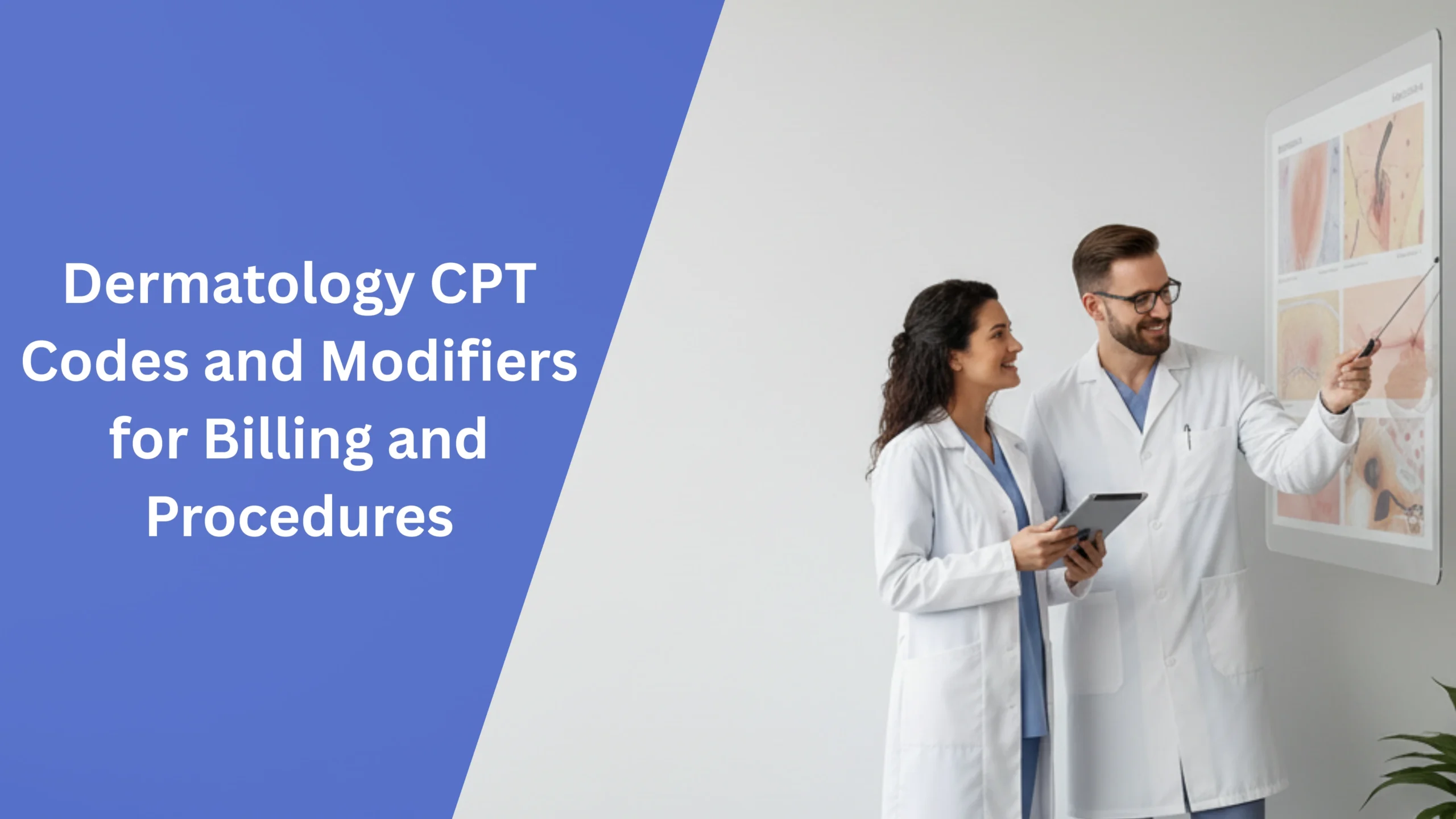Accurate medical coding is a fundamental aspect of successful dermatology practice management. As we progress into 2025, dermatology CPT (Current Procedural Terminology) codes continue to evolve, covering a broad range of services from evaluation and management (E/M) visits to biopsies, lesion destruction, excisions, Mohs surgery, wound closures, phototherapy, pathology services, and telehealth updates. This guide offers an in-depth overview of dermatology CPT codes for 2025, detailing definitions, usage scenarios, Modifiers, ICD-10 Codes and Billing Guidelines.
Evaluation and Management (E/M) Codes
E/M codes are essential for documenting the complexity and scope of patient interactions, providing clarity on the time spent and the decision-making involved in patient care.
New Patient Visits (CPT 99202 – 99205)
These codes apply when a new patient seeks care. A new patient is defined as someone who has not received services from the same provider or specialty group in the past three years. The levels range from straightforward to highly complex cases, based on the duration of the visit and the complexity of the medical decision-making.
- 99202: This code is used for a 15–29 minute visit with straightforward decision-making, suitable for a basic evaluation of a new skin condition.
- 99203: A 30–44-minute visit, typically involving low to moderate complexity, such as the evaluation of a new mole or rash with a planned follow-up.
- 99204: For visits lasting 45–59 minutes, this code is used when moderate complexity is involved, such as a detailed full-body exam for a patient with a suspicious lesion and preparation for a biopsy.
- 99205: A highly complex visit lasting 60–74 minutes, often seen in patients with multiple dermatological concerns or conditions requiring extensive management.
For example, a dermatologist performing a full skin exam on a new patient who presents with a suspicious mole and discusses potential biopsy options would likely use code 99204.
Established Patient Visits (CPT 99211 – 99215)
For follow-up visits and ongoing management of established patients, these codes reflect the time spent and the complexity of the care provided.
- 99211: This minimal service code is typically used for quick follow-ups that require a nurse’s involvement, often around 5–10 minutes.
- 99212: A low complexity visit of 10–19 minutes, where a patient might return for routine follow-up, such as adjusting their treatment plan for eczema or acne.
- 99213: A more detailed visit (20–29 minutes), typically involving a moderate complexity case like the ongoing management of psoriasis or a post-treatment review after a biopsy.
- 99214: Moderate complexity with a 30–39-minute duration. A patient returning for a check-up after starting biologic therapy for psoriasis would likely be coded as 99214.
- 99215: A high complexity visit (40–54 minutes), often involving a patient with multiple concerns or requiring a detailed review of their treatment progress.
Consultation Codes (CPT 99241 – 99245)
These codes are used for consultations requested by another physician. While Medicare no longer reimburses consultation codes, many private insurers still accept them, or they can be replaced by the corresponding office visit codes.
- 99241: A simple consultation lasting approximately 15 minutes.
- 99242: Low complexity consultation of around 30 minutes.
- 99243: Moderate complexity consultation, usually taking about 40 minutes.
- 99244: High complexity consultation, around 60 minutes.
- 99245: Very high complexity consultation, typically lasting 80+ minutes.
Biopsy Codes
Biopsies are critical in dermatology for diagnosing various conditions, especially skin cancer. There are several biopsy codes based on the technique used and the number of lesions sampled.
- 11102: Tangential (shave) biopsy for the first lesion. This is commonly used to remove superficial skin lesions for examination.
- 11103: Each additional tangential lesion. This code is used when additional skin lesions are biopsied using the same technique.
- 11104: Punch biopsy for the first lesion, using a cylindrical blade to remove a deeper sample from the skin.
- 11105: Each additional punch biopsy. Used when additional lesions are biopsied with a punch technique.
- 11106: Incisional biopsy for the first lesion, where only a portion of the lesion is removed for diagnostic purposes.
- 11107: Each additional incisional lesion.
For instance, a dermatologist may perform a shave biopsy on a pigmented nevus and a punch biopsy on a psoriatic plaque in the same visit, using 11102 for the shave biopsy and 11104 for the punch biopsy.
Lesion Destruction Codes
Lesion destruction is commonly used in dermatology to remove or treat precancerous or benign growths, such as actinic keratoses or warts.
Premalignant Lesions (Actinic Keratoses)
- 17000: The first lesion in the treatment of actinic keratoses, often treated by cryotherapy or other methods.
- 17003: For each additional actinic keratosis lesion (2–14).
- 17004: For 15 or more actinic keratosis lesions treated in one session.
A dermatologist might treat ten actinic keratoses on a patient’s scalp with cryotherapy, coding this as 17000 + 17003 x9.
Benign Lesions
- 17110: Removal of up to 14 benign lesions, such as warts or molluscum contagiosum.
- 17111: Removal of 15 or more benign lesions.
For example, a teenager with 20 plantar warts might receive treatment using liquid nitrogen, and this would be coded as 17111.
Excision of Lesions
Excision codes are used for the surgical removal of lesions, with separate codes for benign and malignant growths. These procedures typically involve removing a lesion along with some surrounding tissue to ensure clear margins.
Benign Lesions (CPT 11400–11446)
These codes cover the excision of benign tumors, including simple moles, cysts, and skin tags, where the margins are typically well-defined.
Malignant Lesions (CPT 11600–11646)
These codes are used for excising malignant skin cancers such as basal cell carcinoma, squamous cell carcinoma, and melanoma, with proper margins to ensure full removal of the cancerous tissue.
For instance, the excision of a 2.5 cm basal cell carcinoma from a patient’s neck would be billed as 11623.
Mohs Micrographic Surgery (CPT 17311–17315)
Mohs surgery is a specialized technique where thin layers of cancerous skin are excised and immediately examined under a microscope to confirm clear margins. This procedure is typically used for skin cancers on critical areas, such as the face.
- 17311: First stage of Mohs surgery for head, neck, hands, feet, or genitalia.
- 17312: Each additional stage of Mohs surgery on the same site.
- 17313: First stage of Mohs surgery for the trunk, arms, or legs.
- 17314: Additional stages for Mohs surgery on the trunk, arms, or legs.
- 17315: Additional blocks of tissue removed during Mohs surgery, reported per 5 blocks.
For example, a patient with basal cell carcinoma on the nose who requires two stages of Mohs surgery would be billed as 17311 + 17312.
Repairs and Wound Closure Codes
After excision or trauma, wound closure may be necessary, with codes based on the complexity of the closure.
- 12001–12021: Simple repairs involving the epidermis and dermis only.
- 12031–12057: Intermediate repairs that involve more than just the skin’s surface, such as repairing the subcutaneous tissue.
- 13100–13160: Complex repairs, such as using flaps, stents, or undermining techniques to close the wound.
For instance, a 4 cm layered closure on the scalp following an excision would be billed as 12032.
Phototherapy and Special Treatments
Phototherapy codes are used for treatments that involve the application of light, such as ultraviolet (UV) light therapy, which is commonly used for conditions like psoriasis and eczema.
- 96900: Actinotherapy (UV light therapy) without psoralens, typically used for skin conditions such as psoriasis.
- 96910: Photochemotherapy (tar or petrolatum + UVB), commonly used in combination therapies for skin conditions.
- 96567: Photodynamic therapy (PDT) for premalignant or malignant lesions, especially in the treatment of actinic keratosis.
If a patient undergoes PDT for actinic keratoses on their face, it would be coded as 96567 + J7308 (topical aminolevulinic acid).
Pathology and Lab Work Codes
Pathology plays a crucial role in dermatology for accurate diagnosis, especially with skin biopsies. These codes are used to document the analysis of tissue samples.
- 88304: Surgical pathology, Level III, for gross and microscopic examination of tissue.
- 88305: Surgical pathology, Level IV, which is most commonly used for skin biopsies.
- 88312: Special stains, such as those for fungal or bacterial infections.
- 88341: Immunohistochemistry, single antibody.
For example, a skin biopsy performed to investigate a suspected fungal infection would be billed as 88305 + 88312.
Telehealth Updates for 2025
With the rise of virtual care, the AMA introduced new telehealth CPT codes in 2025, further expanding options for remote consultations.
- 98016: This code is covered by Medicare for telehealth services in dermatology, such as follow-up consultations for acne or skin conditions.
- 98000–98015: These codes are considered invalid under Medicare but may be accepted by private insurers for virtual visits.
For example, a dermatologist conducting a virtual follow-up for acne may bill 98016 if covered by Medicare or use an alternative code under private insurance.
Common Dermatology Modifiers
Modifiers are codes added to the primary CPT (Current Procedural Terminology) code to provide additional information or clarification. These modifiers help avoid claim denials and ensure that the services provided are correctly understood by insurers. Below are some commonly used modifiers in dermatology:
Modifier -25: Significant, Separately Identifiable E/M Service
This modifier is used when an Evaluation and Management (E/M) service is performed on the same day as a procedure. It indicates that the E/M service provided is significant and separate from the procedure performed. For example, if a dermatologist evaluates a new rash and performs a shave biopsy during the same visit, modifier -25 would be added to the E/M code to reflect that two distinct services were provided on the same day.
Modifier -59: Distinct Procedural Service
Modifier -59 is used when two procedures, which are not normally reported together, are performed at different sites or at different sessions. For instance, if a dermatologist performs a destruction of actinic keratoses on one area of the skin and a punch biopsy on a different site, modifier -59 would be used to distinguish the two services as being separate procedures even though they occurred during the same patient encounter.
Modifier -76: Repeat Procedure by the Same Physician
This modifier indicates that a procedure performed earlier in the same session was repeated by the same physician. A common scenario for its use is when cryotherapy is repeated on new actinic keratoses after the initial treatment. This modifier ensures that the payer understands that the same procedure was done multiple times during the same visit.
Modifier -77: Repeat Procedure by Another Physician
Modifier -77 is used when a repeat procedure is performed by a different physician than the one who initially performed the procedure. This could apply in a situation where a second dermatologist repeats a procedure, such as excising a lesion, due to complications or a continuation of care.
Modifier -58: Staged or Related Procedure
This modifier is used when a subsequent procedure is planned and related to the initial procedure, often performed within a set time frame after the first procedure. A typical use would be a staged excision of melanoma after the initial biopsy confirms malignancy. This modifier helps indicate that the second procedure is a part of the treatment plan and is not a new or separate issue.
Modifier -59 vs. -X Modifiers (X{EPS})
The Centers for Medicare and Medicaid Services (CMS) have introduced more specific X modifiers in place of modifier -59 in certain situations for greater clarity. These include:
- XE: Separate encounter
Used when procedures are performed at separate encounters. - XS: Separate structure
Indicates procedures performed on separate structures. - XP: Separate practitioner
Shows that procedures were performed by different practitioners. - XU: Unusual non-overlapping service
Used when procedures are unrelated but occur during the same encounter.
Common Dermatology ICD-10 Codes
ICD-10 codes in dermatology are essential for documenting diagnoses and ensuring the proper medical treatments are provided. These codes must align with the services rendered to avoid any discrepancies, especially when seeking insurance reimbursement. Below are some of the most common dermatology ICD-10 codes, categorized by the condition they represent.
Skin Cancer
C44.0–C44.9: Non-melanoma Skin Cancers
This code group encompasses various non-melanoma skin cancers, such as basal cell carcinoma and squamous cell carcinoma, with specific codes for different sites of occurrence on the body.
C43.0–C43.9: Malignant Melanoma of Skin
These codes represent malignant melanoma, a form of skin cancer that originates in the melanocytes. These codes are further divided by the anatomical site where the melanoma is located.
D04.0–D04.9: Carcinoma in Situ of Skin
Carcinoma in situ represents an early stage of skin cancer, where the malignant cells are confined to their original location and have not spread. This code set captures various forms of carcinoma in situ affecting different areas of the skin.
Premalignant Lesions
L57.0: Actinic Keratosis
Actinic keratosis refers to a precancerous condition caused by prolonged sun exposure, where thick, scaly patches appear on the skin. If left untreated, it can progress into squamous cell carcinoma.
L57.8: Other Skin Changes Due to Chronic Sun Exposure
This diagnosis code captures other skin alterations such as sunburn, skin aging, or photodamage resulting from long-term exposure to ultraviolet light.
Benign Skin Conditions
D23.0–D23.9: Benign Neoplasms of Skin
These codes are used to categorize various benign (non-cancerous) skin growths, including moles and other types of skin tumors that are site-specific.
L82.0: Inflamed Seborrheic Keratosis
Seborrheic keratosis is a common benign tumor on the skin. When these growths become inflamed, they may be diagnosed with this code.
L82.1: Other Seborrheic Keratosis
This code is used for seborrheic keratosis that is not inflamed but still requires medical attention or removal.
B07.9: Viral Wart, Unspecified
This code is used when a wart, caused by a viral infection, is diagnosed but the specific type of wart (e.g., common, plantar) is not identified.
B08.1: Molluscum Contagiosum
Molluscum contagiosum is a viral skin infection that causes raised, pearly papules on the skin. This infection is contagious and often affects children.
Inflammatory Dermatoses
L40.0–L40.9: Psoriasis
Psoriasis is a chronic autoimmune condition that causes red, scaly patches on the skin. These codes capture different types of psoriasis, including plaque, guttate, and pustular psoriasis.
L20.9: Atopic Dermatitis, Unspecified
Atopic dermatitis, commonly known as eczema, is a chronic condition that causes itchy, inflamed skin. This code is used when the specific type of dermatitis is not defined.
L30.9: Dermatitis, Unspecified
Dermatitis refers to inflammation of the skin. This code is used when the specific cause of the dermatitis is unclear, but the condition is diagnosed as a general form of dermatitis.
L50.9: Urticaria, Unspecified
Urticaria, commonly known as hives, is characterized by red, itchy welts on the skin. This code is used when the exact cause or trigger for the hives is not determined.
Infectious Skin Diseases
B35.0: Tinea Barbae/Tinea Capitis
Tinea barbae refers to a fungal infection of the beard area, while tinea capitis affects the scalp. Both are caused by dermatophyte fungi and can lead to hair loss.
B35.3: Tinea Pedis (Athlete’s Foot)
Athlete’s foot is a common fungal infection of the feet, often causing itching, burning, and peeling skin, particularly between the toes.
B35.4: Tinea Corporis (Ringworm)
Ringworm is a superficial fungal infection that causes round, red, itchy patches on the skin. It is highly contagious and can spread through direct skin-to-skin contact.
B37.2: Candidiasis of Skin and Nails
Candidiasis is a yeast infection caused by the fungus Candida, which can affect the skin, especially in moist areas, and the nails.
L01.0: Impetigo
Impetigo is a highly contagious bacterial skin infection that causes red sores or blisters, typically found on the face, especially around the nose and mouth.
Pigmentary Disorders
L81.0: Post-inflammatory Hyperpigmentation
This condition occurs when dark spots or patches appear on the skin after an injury or inflammation has healed. The skin produces excess melanin, resulting in pigmentation changes.
L81.2: Freckles
Freckles are small, brown spots on the skin that are typically genetic and are often more noticeable after sun exposure. They are harmless but can sometimes be confused with other skin conditions.
L81.4: Melasma
Melasma is a common skin condition that causes dark, discolored patches, typically on the face. It is often triggered by hormonal changes, such as pregnancy or birth control use.
L80: Vitiligo
Vitiligo is a condition where the skin loses pigment, resulting in patches of lighter skin. It occurs when the body’s immune system attacks the pigment-producing cells, melanocytes.
Hair and Nail Disorders
L64.9: Androgenic Alopecia
Androgenic alopecia, commonly known as male or female pattern baldness, is a genetic condition causing hair thinning or loss, particularly on the scalp.
L65.9: Non-scarring Hair Loss, Unspecified
This code is used for hair loss that does not result in scarring of the scalp. Causes can include stress, nutritional deficiencies, or hormonal imbalances.
L60.0: Ingrowing Nail
Ingrown nails occur when the edges of the nails grow into the surrounding skin, typically on the toes, causing pain and potential infection.
L60.2: Onychogryphosis
Onychogryphosis is a nail condition where the nail becomes thickened and distorted, often due to trauma or a fungal infection.
Dermatology Billing Guidelines
Comprehensive Documentation
Comprehensive documentation is one of the foundational elements of successful billing in dermatology. Accurate and thorough medical records are essential for ensuring that services provided align with the CPT (Current Procedural Terminology) and ICD-10 (International Classification of Diseases) codes used for billing. This includes documenting patient history, clinical findings, treatment plans, and time spent on services. For example, a dermatology visit for a suspicious mole would require documentation of the patient’s medical history, a detailed examination of the lesion, and the proposed treatment plan, ensuring that the codes reflect the exact nature of the visit. Thorough documentation not only helps in avoiding claim denials but also serves as a critical reference in the event of payer audits or medical reviews.
Coding Accuracy
Coding accuracy is another critical aspect of dermatology billing. The proper selection of CPT and ICD-10 codes ensures that the procedures performed and the diagnoses are accurately matched. Inaccurate or incomplete coding can lead to claim denials or delayed reimbursements. For instance, a biopsy procedure should be coded based on the specific technique used whether a shave, punch, or incisional biopsy. Each technique has a unique CPT code, and selecting the correct code is crucial. Additionally, diagnosis codes, such as those for skin cancer or psoriasis, should be precise and reflect the condition being treated. Dermatologists must stay updated with coding changes to ensure that they are using the most current and correct codes.
Medical Necessity
Medical necessity is a key principle that underpins proper billing. Healthcare providers must ensure that the services they render are medically necessary for the patient’s condition and that the treatments align with established clinical guidelines. Insurance companies, including Medicare, require that services be justified based on medical necessity. For example, a biopsy for a suspicious mole would be considered medically necessary if there is clinical evidence suggesting malignancy or atypical growth. Properly documenting medical necessity ensures that the submitted claim aligns with the insurer’s requirements and increases the likelihood of reimbursement. Failing to demonstrate medical necessity can lead to claim denials or audits.
Use of Modifier
The use of modifiers is another important element in dermatology billing, as modifiers provide additional context for the services rendered. Modifiers clarify the circumstances under which a procedure was performed and indicate whether certain services were done separately, repeated, or staged. For instance, if a dermatologist performs a biopsy and an evaluation on the same day, Modifier -25 would be used to indicate that the Evaluation and Management (E/M) service was significant and separate from the procedure. Similarly, Modifier -59 would be used when two unrelated procedures are performed at different sites during the same visit, helping to avoid bundling issues. Correctly using modifiers ensures that the payer understands the full scope of the services provided, reducing the chances of claim rejections.
Bundle-up Services
Bundling services is a common practice in dermatology, where related services provided in a single encounter are combined into a single CPT code. This is often seen with lesion destruction codes, where multiple lesions treated during one session are bundled under a single billing. For example, if a dermatologist treats ten actinic keratoses with cryotherapy, the first lesion would be billed under 17000, with additional lesions billed using 17003 or 17004, depending on the number of lesions treated. While bundling helps to streamline billing, dermatology practices must be careful to avoid underreporting services. Insurers may have specific guidelines on bundling, and failing to follow these rules could lead to reduced reimbursements.
Clear Patient Communication
Finally, clear patient communication plays a pivotal role in ensuring that patients understand the billing process, which in turn reduces the likelihood of payment disputes. It is crucial to explain to patients the costs of procedures, especially when insurance may not fully cover certain treatments or when there are out-of-pocket expenses.
For instance, a patient undergoing photodynamic therapy for actinic keratoses should be informed of the potential costs, including co-pays, deductibles, and any non-covered services. By maintaining transparency about costs, insurance coverage, and billing procedures, dermatology practices can foster trust with patients and minimize confusion when they receive bills. Clear communication ensures that patients are prepared for what to expect financially, reducing administrative burden and patient dissatisfaction.With numerous billing challenges to handle and various dermatology coding guidelines to follow, it’s common to feel overwhelmed. However, if you prefer not to manage billing and coding internally, you can outsource dermatology billing to a professional medical billing company.
Conclusion
In dermatology CPT coding continues to evolve, offering greater precision in billing and reimbursement. Understanding the various CPT codes for E/M visits, biopsies, excisions, Mohs surgery, lesion destruction, phototherapy, pathology services, and telehealth is crucial for dermatologists, practice managers, and medical billers to ensure correct documentation and avoid claim denials. Staying up-to-date with these codes ensures compliance, accurate reimbursement, and optimal patient care.
We trust that this detailed guide will act as a valuable resource for your dermatology practice in managing its billing and coding needs. However, if you encounter any challenges, consider partnering with a professional medical billing and revenue cycle management (RCM) service provider like NexusIO to ensure smooth and efficient operations.





